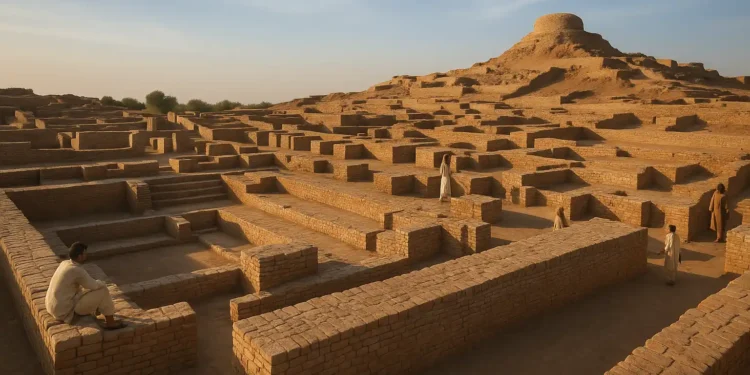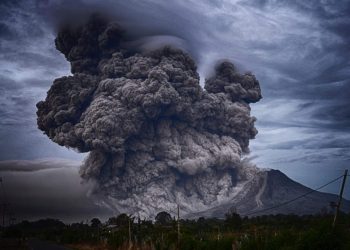The lost desert city of Loulan lies buried beneath the sands of China’s Taklamakan Desert, hidden in one of the harshest places on Earth. Once a crucial stop on the Silk Road, Loulan offered water, shelter, and trade in a region where survival was never guaranteed. Today, its remains are scattered fragments, wooden posts, scraps of cloth, handwritten documents — all slowly disappearing beneath shifting dunes. The city vanished sometime after the 4th century, leaving behind more questions than answers.
The lost desert city of Loulan
The location of Loulan was both strategic and precarious. It rose near the Lop Nur basin in the northeastern Tarim Basin, where the Tarim River once curved through arid steppe and barren salt flats. Though the region is now one of the driest in the world, ancient Loulan thrived because of this shifting river system, which brought just enough water to support small-scale agriculture, wells, and a fortified settlement.
Historical references to Loulan appear as early as the second century BCE, when Chinese emissaries from the Han dynasty ventured west to forge alliances and expand trade. Positioned at the crossroads of the northern and southern routes of the Silk Road, Loulan became a resting point for caravans carrying silk, jade, glassware, and other goods across Central Asia. It linked Chang’an (modern Xi’an) with cities as far away as Samarkand and the Persian heartland.
But Loulan was not merely a stopover. It collected tolls, hosted diplomatic envoys, and maintained regional power through trade, alliance, and control of desert water sources. Its location allowed it to mediate between the Han Empire to the east and nomadic powers like the Xiongnu to the north and west. For a desert city with no monumental stone walls or great towers, its influence far exceeded its size.
A cultural crossroads on the edge of empire
Archaeologists have found evidence that Loulan was far from isolated. Chinese writing appears on wooden documents recovered from the site, alongside coins from distant regions and fabrics made of both silk and wool. Some objects bear the seal of the Han Empire, which suggests that Loulan was tied into larger political and trade networks, not simply surviving on its own.
The people who lived there were likely a mix of cultures. Which makes perfect sense. Some belonged to Indo-European groups, possibly the Saka or Tocharians. Others came from Han Chinese territories or Central Asian steppe communities. That diversity shows up in the way they buried their dead, in the clothes they wore, and even in the way they built their homes. Several houses were constructed with timber frames packed with reed and clay, a practical solution for the harsh desert winds and cold nights.
One of the most fascinating discoveries made near Loulan wasn’t from its peak period, but from much earlier. Buried in the sand, researchers found the body of a woman who died around 1800 BCE. Her skin had dried naturally in the desert air, preserving her features and clothing. She wore a wool garment and soft leather shoes. Her hair was still in place. Though she lived more than a thousand years before Loulan’s rise, her presence shows that people had been living in this region long before recorded history reached it.
The city’s disappearance
By the fourth century CE, Loulan was abandoned. There are no signs of battle, no charred remains, no broken city walls. It didn’t fall in war. It was simply left behind. Like many, many other ancient cities across the world. Coincidence? Well, not really. More like nature at play.
According to experts, the best explanation is the river. The Tarim, which had sustained Loulan for centuries, changed course. Without that water, the fields dried out. The wells went empty. Trade stopped. And then, so did life in the city.
Chinese records mention the decline, but only in passing. In 260 CE, an official was appointed to take control of Loulan on behalf of the imperial court. After that, the flow of messages and envoys seems to have ended. By the early fourth century, Loulan disappears from the written record.
There may have been other problems. The region was drying out, and caravan routes were shifting. New paths made older cities less useful. Some historians point to rising tension between the Han Empire and the western kingdoms. But most agree the city died with the river.
Rediscovery and excavation
Loulan stayed buried for over a thousand years. In 1899, the Swedish explorer Sven Hedin found the first evidence of it near Lop Nur. What he saw looked like the remains of a small settlement. There were pieces of timber, broken tools, and part of a wall sticking out of the sand.
A few years later, Aurel Stein arrived. He and his team began the first detailed excavations. They found wooden documents with Chinese characters, pottery fragments, scraps of cloth, and everyday tools. These items confirmed that a city had once stood there. They also showed that it had been part of the wider Silk Road system, connected to trade and politics far beyond the desert.
Loulan had no palaces, no stone monuments, and no riches buried beneath its streets. But it was real. It had fed travelers, moved goods, and connected worlds. Without places like Loulan, the Silk Road would not have worked.
What Loulan reveals
But again, as I have mentioned previously, Loulan’s story isn’t unique. All over the world, desert cities have come and gone. When water disappears, people leave. It happened in Petra. It happened in Niya. And it happened here.
For generations, Loulan survived in an extreme climate. It was supported by a river, linked to empires, and built to last just long enough. But none of that could save it when the river changed direction. This tells us a clear message. Nature can dictate how we live. But given how little we seem to care about nature, we apparently don’t understand that yet.
But more importantly, I think that what happened in Loulan is easy to overlook because it happened quietly. There was no dramatic fall. No invasion. Just silence. That pattern hasn’t gone away. Water shortages and shifting landscapes are still shaping human life today.
So we can say that Loulan isn’t remembered for what it built, but for where it stood and what it made possible. It was one of many places that held the Silk Road together. And when it was no longer useful, the desert took it back.











